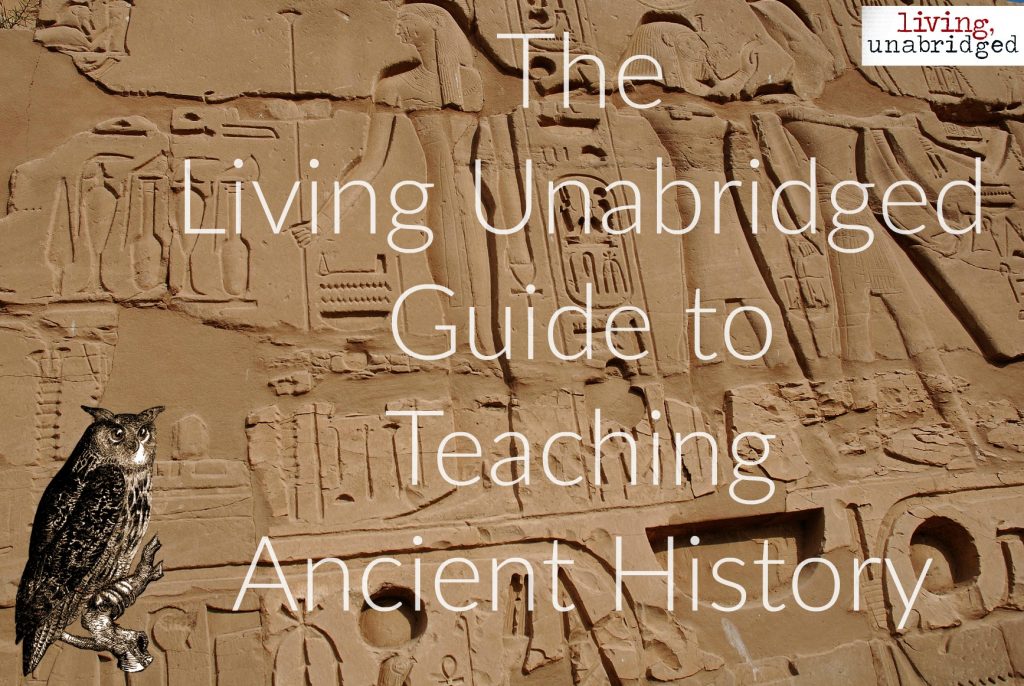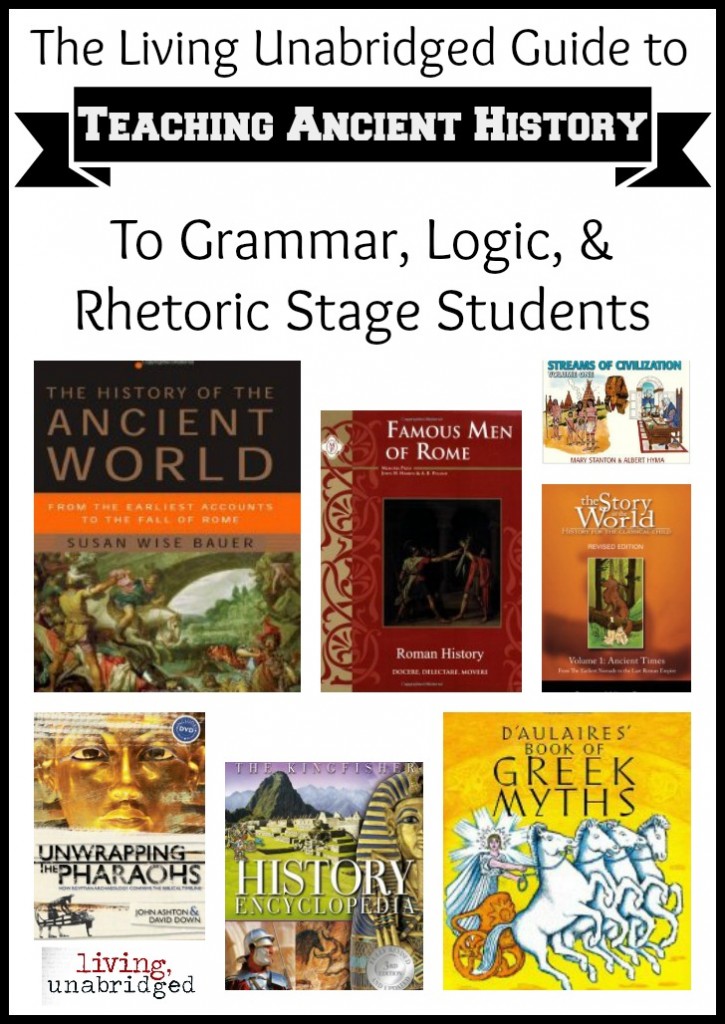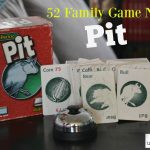One of my favorite suggestions from The Well-Trained Mind: A Guide to Classical Education at Homewas the plan to cover History in four year cycles. I started teaching ancient history when my oldest was roughly First Grade age and now we're in our third rotation. For her, this is her last time through the cycle. (I'd say something here about how time flies, but all you moms already know how true it is.)
What I have now, that I didn't then, is a child in each stage. I haven't started each child with Ancients in the First Grade-ish level. That would mean I had students in different stages of History and, as they say in the vernacular, "Ain't nobody got time for that."
We've simply added each child to our studies as they were able. So, it won't work out perfectly where each child gets all History in 3 four-year cycles. And that will be OK. All of History will be covered at least twice in a student's K-12 home education. I'm choosing to celebrate that instead of worrying.
So, anyway, this year we're doing Ancient History and I have students in all three stages (Grammar, Logic, Rhetoric).
History Spines for Teaching Ancient History
We have a spine for each student. This is what the rest of our studies are based on and gives a rough shape to what we cover and when.
Grammar Stage:
Logic Stage:
The Kingfisher History Encyclopedia
Rhetoric Stage:
The History of the Ancient World: From the Earliest Accounts to the Fall of Rome
This text can be supplemented with:
Study and Teaching Guide: The History of the Ancient World
. We have this but we are following it very loosely.
Alternative:
My oldest chose to read both of these, simply because we had them both on hand, she loves to read, and she is able to do so.
What We Do Each Week:
My Grammar and Logic stage students listen to The Story of the World audiobook. (Actually, it's mp3 tracks on our computer.)
The Story of the World, Activity Book 1: Ancient Times - From the Earliest Nomad to the Last Roman Emperor
. I print the coloring pages (and any other related coloring pages I've found) for any child who wants them. (Including our five year old who likes to listen along). My Grammar and Logic students do the mapwork. Sometimes I add assignments to the Logic age student because the map work in this activity book tends to be very simple.
When I'm looking for extra maps for mapwork I always check Notebooking Pages first:

We also have a supplemental lapbook I downloaded long ago from a no longer active blog. I'd love to share it with you but I honestly cannot find the blogger any more.
That's it for the Grammar student (except for supplemental reading).
My Logic age student reads the assigned portion of The Kingfisher History Encyclopediaand fills in her outline page. My oldest daughter had to do these outlines on her own with notebook paper but our second daughter struggles more with that type of assignment so my husband created this page for her:
history_note_page01 (Right click to open this pdf image. Feel free to save and use!)
My Rhetoric age student takes notes while she reads her chapter and then discusses the chapter with me. (Usually) She is copying the maps and keeping them in her own notebook. She can add dates to a timeline in her notebook. She is also copying suggested vocabulary from her Streams book.
Then, of course, there's all the wonderful supplemental reading available.
Supplemental Reading for Teaching Ancient History
There are many, MANY great book lists available (including in the SOTW Activity Guides), so in this post I'll just share a few of our favorites.
About Egypt:
Unwrapping the Pharaohs: How Egyptian Archaeology Confirms the Biblical Timeline
by John Ashton and David Down. I actually use this almost as a spine in the middle grades by either reading it aloud or assigning sections to the student and then having the student narrate or write down the main points. (You may also wish to look into Unveiling the Kings of Israel: Revealing the Bible's Archaeological History
also by David Down.) We also use this when putting together our timeline notebooks or timelines.
Tales Mummies Tell
by Patricia Lauber. Recommended for older readers.
Tales of Ancient Egypt
by Roger Lancelyn Green. Makes a good read-aloud.
How to Read Egyptian Hieroglyphs: A Step-by-Step Guide to Teach Yourself, Revised Edition
Great for middle grades up through adults.
Hieroglyphs from a to Z: A Rhyming Book With Ancient Egyptian Stencils for Kids
Good for strong readers and those with an artistic bent.
Hieroglyphs
great for young or reluctant readers.
About Assyria:
Amazon doesn't have an image ofArabian Nights: Three Talesby Deborah Lattimore but this is a great edition with intricate illustrations.
Gilgamesh the King
. This is part of a picture book series retelling of Gilgamesh.
About Greece:
D'Aulaires' Book of Greek Myths
A classic in its own right.
Famous Men of Greece
. Similar in format to FMoR (below).
The Children's Homer: The Adventures of Odysseus and the Tale of Troy
by Padraic Colum. Great for reading aloud.
The Librarian Who Measured the Earth
A favorite picture book.
About Rome:
Famous Men of Rome
. Another one I assign in the middle grades (Logic stage). The student reads the section and then narrates to me what she remembers about each person. We might fill out a notebooking page, or we might not. Some of my children have loved notebooking more than others.
If you have a child who wants to "see how it works", then these books by Macaulay are a must.
DK has several nonfiction looks at Rome, but this is one my family happens to own.
Classical Kids: An Activity Guide to Life in Ancient Greece and Rome (Hands-On History)
This would come in handy, especially if you aren't using the Story of the World activity book.
In a nutshell, we're all studying the same period but each student goes deeper as she's able. Our oldest has a lengthier, deeper reading list. But even this spills over for the younger students because she listens to some of her books on audio. So, for instance, they have all listened to The Odyssey. (all 12.5 unabridged hours!)
What are your favorite tips and resources for teaching ancient history?
For more ideas about teaching ancient history to the three stages:
Follow Karen (Living Unabridged)'s board Homeschooling - SOTW 1 on Pinterest.
If you're looking for some great printable notebooking pages:




































We are doing ancient history this year in my scholé group and many of my resources look similar! My kids are all in early grammar stage, so we mostly use SOTW, CC Timeline Cards, notebookingpages.com, and then I go to the library and get other books for the kids to look at freely. I think they are getting a good introduction and I am learning a considerable amount! =) Thanks for sharing all of these great resources!
[…] Teaching all three stages at the same time is challenging. Karen at Living Unabridged shares just how she’s Teaching Ancient History to Grammar, Logic, and Rhetoric Stages. […]
[…] Teaching Ancient History to Grammar, Logic, and Rhetoric Stages ~ Living Unabridged […]